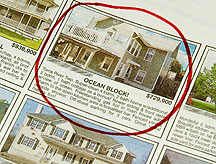Beauty without utility bills
When a Hawaii couple had to replace their roof, they seized the chance to become energy independent.
 |
| The Harrisons' home BEFORE |
 |
| The Harrisons' home AFTER |
| 30 yr fixed | 3.80% |
| 15 yr fixed | 3.20% |
| 5/1 ARM | 3.84% |
| 30 yr refi | 3.82% |
| 15 yr refi | 3.20% |
(Money Magazine) -- Few homeowners can get excited about a costly maintenance project. But when John and Anne Harrison needed to put a new roof on their 50-year-old Oahu, Hawaii home four years ago, they saw an opportunity.
Working with architect Paul Noborikawa, they raised the roof over the dark living room, added more windows and enclosed an outdoor lanai, giving them a bigger and lighter space that seemingly merges with the surrounding dense woods and garden.
But John had even loftier ideas: installing solar water heating and photovoltaic power to take advantage of their hometown's 325 sunny days a year. Now roof panels generate the home's electricity and heat its water.
The couple's electric bill has gone from more than $150 a month to $16, the cost of being connected to Oahu's power grid. Over the course of the year they produce about 300 more kilowatt-hours than they use, feeding the excess back into the grid.
"A lot of my motivation has to do with being an educator," says John, the retired director of the University of Hawaii's environmental center. "People learn by example."
The low ceiling made the living room dark, so the Harrisons raised the roof by three feet.
New windows ($13,500) give them a wide view of the foliage around the house, and two Pella 15-pane French doors ($2,000) bring in more fresh air. Low-voltage halogen fixtures and task lighting ($5,500) illuminate the room from all angles.
The floors that replaced the carpet are made from spotted gum ($32,000), an Australian wood that's considered environmentally friendly because of its abundance.
The new living room, roof and solar power systems ate up about 30% of the total costs. The rest went toward landscaping, a new driveway and the conversion of an unusable Japanese bathhouse into a guesthouse.
"They've done some really terrific things," says Nancy Metcalf, a local realtor with Coldwell Banker Pacific Properties. "They opened up the area so that it brings in the greenery from the yard, and although the house is surrounded by trees, you don't feel darkness. It's what people shopping in the neighborhood are looking for."
With a solar hot-water heater ($3,750) and a photovoltaic power system ($56,000), the Harrisons produce more electricity than they consume.
Good airflow, ceiling fans and strategic landscaping mean no need for AC. When temperatures dip, the great room's fireplace (not shown) provides the heat they need.
DO rely on plate glass to connect the outside and inside visually, and set windows high to bring natural light into narrow, deep spaces.
DON'T create large expanses of glass if you live in a cold climate. At best, glass is a tenth as effective as an insulated wall for keeping in heat.
DO install low built-ins below large windows. They will give you maximum storage space - but won't compete with your views.
DON'T choose walls of glass without extending the eaves out by at least a foot. An overhang cuts down on glare, unwanted heat and window wear.
DO put in wood floors for the greatest durability. (But add rugs, upholstery and curtains to reduce the echo from hard surfaces and high ceilings.)
DON'T use plywood on windowsills or top surfaces. Solid wood costs more ($20 per running foot) but also holds up better to the sun's rays.
DO spend extra on ceiling insulation (40% more for materials). Heated air is lost through the roof; cooled air is warmed. So a hot attic strains the AC.
DON'T neglect reversible ceiling fans, which pull cool air in when it's hot outside and push warm air down when it's not ($500 to $1,000 each, installed).
DO use track lighting to illuminate a large space for less. But spend $500 per track for an extra circuit so you can light different zones separately.
DON'T place any fixtures tight to high ceilings. That's wasted light so far above your head. And lights directly over a fan create a strobe effect.
--Do's and Dont's from Money Magazine contributing writer Duo Dickinson, who is an architect in Madison, Conn. ![]()
Send feedback to Money Magazine



